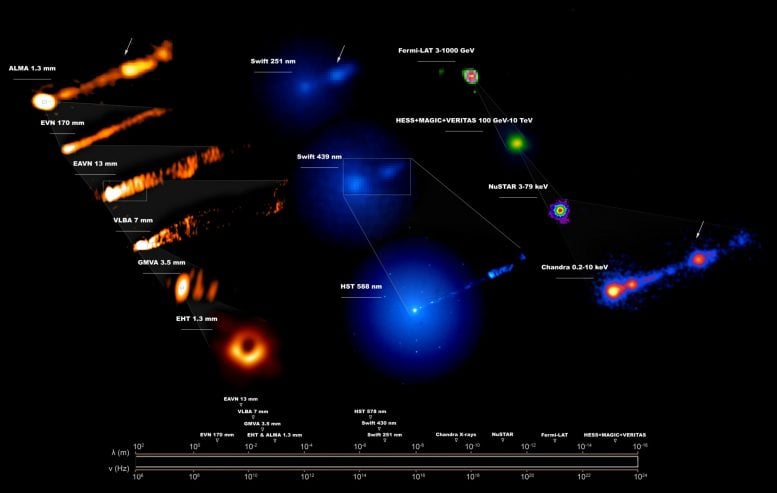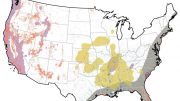
Composite image showing how the M87 system looked, across the entire electromagnetic spectrum, during the Event Horizon Telescope’s April 2017 campaign to take the iconic first image of a black hole. Requiring 19 different facilities on the Earth and in space, this image reveals the enormous scales spanned by the black hole and it forward-pointing jet, launched just outside the event horizon and spanning the entire galaxy. Credit: The EHT Multi-wavelength Science Working Group; the EHT Collaboration; ALMA (ESO/NAOJ/NRAO); the EVN; the EAVN Collaboration; VLBA (NRAO); the GMVA; the Hubble Space Telescope; the Neil Gehrels Swift Observatory; the Chandra X-ray Observatory; the Nuclear Spectroscopic Telescope Array; the Fermi-LAT Collaboration; the H.E.S.S collaboration; the MAGIC collaboration; the VERITAS collaboration; NASA and ESA. Composition by J. C. Algaba
- Scientists have coordinated observations of many of the world’s most powerful telescopes of the supermassive black hole in the galaxy M87.
- In April 2019, the Event Horizon Telescope (EHT) released the first direct image of this black hole.
- By combining the EHT data with those from different kinds of light, scientists can learn more about the black hole’s properties.
- Astronomers have used NASA’s Chandra X-ray Observatory to study M87 for two decades, including during this coordinated campaign.
In April 2019, scientists released the first image of a black hole in the galaxy M87 using the Event Horizon Telescope (EHT). This supermassive black hole weighs 6.5 billion times the mass of the sun and is located at the center of M87, about 55 million light-years from Earth.
The supermassive black hole is powering jets of particles that travel at almost the speed of light. These jets produce light spanning the entire electromagnetic spectrum, from radio waves to visible light to gamma rays.
To gain crucial insight into the black hole’s properties and help interpret the EHT image, scientists coordinated observations with 19 of the world’s most powerful telescopes on the ground and in space, collecting light from across the spectrum. This is the largest simultaneous observing campaign ever undertaken on a supermassive black hole with jets.
The NASA telescopes involved in this observing campaign included the Chandra X-ray Observatory, Hubble Space Telescope, Neil Gehrels Swift Observatory, the Nuclear Spectroscopic Telescope Array (NuSTAR), and the Fermi Gamma-ray Space Telescope.
Beginning with the EHT’s now iconic image of M87, a new video takes viewers on a journey through the data from each telescope. The video shows data across many factors of ten in scale, both of wavelengths of light and physical size. The sequence begins with the EHT image of the black hole in M87 released in April 2019 (the data was obtained in April 2017). It then moves through images from other radio telescope arrays from around the globe, moving outward in the field of view during each step. (The scale for the width of squares is given in light years in the bottom right hand corner).
Next, the view changes to telescopes that detect visible light (Hubble and Swift), ultraviolet light (Swift), and X-rays (Chandra and NuSTAR). The screen splits to show how these images, which cover the same amount of the sky at the same time, compare to one another. The sequence finishes by showing what gamma ray telescopes on the ground, and Fermi in space, detect from this black hole and its jet.
Throughout the sequence the smallest detail that the array or telescope can see increases in size by a large amount. For example the smallest details that the EHT, Chandra, and Fermi can see are 0.0067, 130 and 330,000 light-years respectively. Only the EHT can detect the black hole’s shadow, and at the other extreme, Fermi is not able to determine whether the gamma ray emission it detects comes from regions close to the black hole, or from the jet.
The data were collected by a team of 760 scientists and engineers from nearly 200 institutions, 32 countries or regions, using observatories funded by agencies and institutions around the globe. The observations were concentrated from the end of March to the middle of April 2017.
For more on this research, see Telescopes Unite in Unprecedented Observations of Famous Black Hole Across the Entire Electromagnetic Spectrum.
Reference: “Broadband Multi-wavelength Properties of M87 during the 2017 Event Horizon Telescope Campaign” by The EHT MWL Science Working Group, J. C. Algaba, J. Anczarski, K. Asada, M. Baloković, S. Chandra, Y.-Z. Cui, A. D. Falcone, M. Giroletti, C. Goddi, et al., 14 April 2021, Astrophysical Journal Letters.
DOI: 10.3847/2041-8213/abef71
This paper was led by 33 members of the EHT Multiwavelength Working Group, and includes as coauthors members of the following collaborations: the entire Event Horizon Telescope Collaboration; the Fermi Large Area Telescope Collaboration; the H.E.S.S collaboration; the MAGIC collaboration; the VERITAS collaboration and the EAVN collaboration. The coordinators of the EHT Multiwavelength Science Working Group are Sera Markoff, Kazuhiro Hada, and Daryl Haggard, as well as coordinating work on the paper. Juan Carlos Algaba and Mislav Baloković also coordinated work on the paper.
The 2017 campaign involved a large number of observatories and telescopes. At radio wavelengths it involved: the European Very Long Baseline Interferometry (VLBI) Network (EVN) on May 9, 2017; the High Sensitivity Array (HSA), which includes the Very Large Array (VLA), the Effelsberg 100m antenna and the 10 stations of the National Radio Astronomy Observatory (NRAO) Very Long Baseline Array (VLBA) on May 15, 16 and 20; the VLBI Exploration of Radio Astronomy (VERA) over 17 different times in 2017; the Korean VLBI Network (KVN) over seven epochs between March and December; the East Asian VLBI Network (EAVN) and the KVN and VERA Array (KaVA) , over 14 epochs between March and May 2017; the VLBA on May 5, 2017; the Global Millimeter-VLBI-Array (GMVA) on March 30, 2017; the Atacama Large Millimeter/submillimeter Array (ALMA); the Submillimeter Array (SMA) as part of an ongoing monitoring program. At ultraviolet (UV) wavelengths it involved the Neil Gehrels Swift Observatory (Swift) with multiple observations between March 22 and April 20, 2017; and at optical wavelengths: Swift; and the Hubble Space Telescope on April 7, 12, and 17, 2017. (The Hubble data were retrieved from the Hubble archive because it was part of an independent observing program.) At X-ray wavelengths it involved the Chandra X-ray Observatory on April 11 and 14, 2017; the Nuclear Spectroscopic Telescope Array (NuSTAR) on April 11 and 14, 2017; and Swift. At gamma-ray wavelengths it involved Fermi from March 22 to April 20, 2017; the High Energy Stereoscopic System (H.E.S.S); the Major Atmospheric Gamma Imaging Cherenkov (MAGIC) telescopes, and the Very Energetic Radiation Imaging Telescope Array System (VERITAS).
NASA’s Marshall Space Flight Center in Huntsville, Alabama, manages the Chandra program for NASA’s Science Mission Directorate in Washington. The Smithsonian Astrophysical Observatory in Cambridge, Massachusetts, controls Chandra’s science and flight operations.
The EHT Multi-wavelength (MWL) Working Group is a collective of EHT Collaboration members and external partners working together to ensure broadband MWL coverage during EHT campaigns, to maximize science output. The EHT collaboration involves more than 300 researchers from Africa, Asia, Europe, North and South America. The international collaboration is working to capture the most detailed black hole images ever obtained by creating a virtual Earth-sized telescope. Supported by considerable international investment, the EHT links existing telescopes using novel systems — creating a fundamentally new instrument with the highest angular resolving power that has yet been achieved.










Why zoom out, not in? Why start with the end in mind? Ends don’t justify the neans.
Feels fake to me. Just doesn’t feel genuine. It just doesn’t make sense. Why and how would there be a hole in relatively empty space? Unless all of space is a hole, down which all matter is ‘falling’. But it seems objects of smaller mass tend to fall towards objects of greater mass.
This idea of blackholes started in scifi.
I’m not an expert or astrophysics professional. It just doesn’t make sense. Someone is pulling someone’s leg here. I assume male anti-female conspiracy; keep amateur females busy and out of the good old boy network. Ask the pope, plz.
I could use expletives, but I could be wrong too.
What time is it, plz?
Hello I have a picture I’d like to show you that is like yours how can I get it to you please
[email protected]
Thanks buddy but I keep my own time; (sometimes I lose it). Time is just a measure of movement. Time is always now.
Don’t tell me this lie is the big plan to force Orientalists to go west. To turn shoots into roots. While for males it may make sense, not really for females. And males (moon) generally are attached to femakes (Earth, mother or wife).
Come on. Its perfectly clear in all pictures of galaxies that the center is a giganticly hugmungous supermassive star! The center of the Causmos probably something bewilderingmy larger, umless galaxies are networked.
This then follows that like normal stars supermassive galactic core stars may also go supernovae spreading their heavier elements out into the relative void, perhaps starting the process of condensation and mixing again. And so perhaps galaxies go or have gone thru various such cycles. Perhaps the end result will be an actual superdupper massive star of all galaxies together and that famous big bang finale. Umless there is a source to energy or subatomic particles exactly from nothing. Yes, I see how it might be possible that galaxies grow & blow out & in.
Explains why plants grow upwards and downwards. Why there are western materialists, scientists & atheists and oriental spiritualists, intuition, trust/faith and implicit/unconscious theists. Day and night cycles. Etc.
As Kabbalahists says: as above so below; as outside, so inside.
Has anyone considered that the Causmos is one big blackwhole?
Joke aside, the darkness & relative emptiness of space is the real blackwhole. Is this what ‘dark matter’ is about? The darkness of space? Maybe its dark b/c there isn’t enough light.
Or maybe b/c truth is stranger than fiction? Reality weirder than imagination [of reality]. Maybe our perceptions and instruments of observation are not yet developped enough to observe & image the world around us & ourselves.
Until then, keep looking at the SUN!🌞 (directly, intensely, hungrily). Some day we’ll eat it and all the others.🤖👽
Marin, what are you smoking mate?
L💛ve…….for Science/Knowing and a better future.
Sorry; I don’t smoke.
I love truth and hate lies. This ‘blackhole’ stuff seems like fiction maybe soon to be fact (how to destroy a star; siphon off hydrogen from stars.
What’s it going to take to get the truth? (A: Lies) :/
I don’t see any natural ‘blackholes’, but man-made ideation possibly.
Why is the sun self-sustaining? Its maintains a relative balance between attractive forces and repulsive forces. Same with galactic center stars. Its a huge star.
But if not, you can’t call the magnetic fields/forces created by gas, dust, planets and stars ‘blackholes’. Its nonsense and creates a ‘blackhole’ in your mind trying to imagine literally nothing.
Now blackwhole makes more sense as space is relatively empty, cold & dark. Its like space-time idea…its backwards. Space doesn’t push matter together, does it? I think matter attracts via opposite charges. And repulsion might be this so called dark energy, but its weak and can be overcome by attractive force which is probably what holds a star together.
Theory of everything is inverse of theory of nothing. To know/see/observe everything be nothing. To know/see/observe nothing, be everything.
Thanks for asking mate; sorry for the weirdness. Closer to Truth (via lies oddly enough). Truth thru lies and peace thru war. Life thru death. Order thru chaos. Trust thru deceit. Wow. Now, thats crazy?! (I am partially in a simulation.)
It is crazy. Peace thru peace. Truth thru truth. Life thru life. Order thru order. But there is duality for a reason. Plants grow up & down. Day & night, male & female. Maybe each has their own specialty and there is an attracting mechanism keeping everything in motion.
Eye could be wrong. Eye’ve never actually observed the galactic central region. Eye logically inferred. Likewise a blackwhole is literally what space is; to say there is a blackhole in a blackwhole is a little weird. Should consult someone with more spacial capability/intelligence.
Sorry and apollogy.
Black holes aren’t holes, Marin. Ffs. Why are all conspiracist nuts like this. Fyi, “logic” and the use of it is limited to what one’s mind knows and perceives. You might want to brush up on *basic knowledge*.